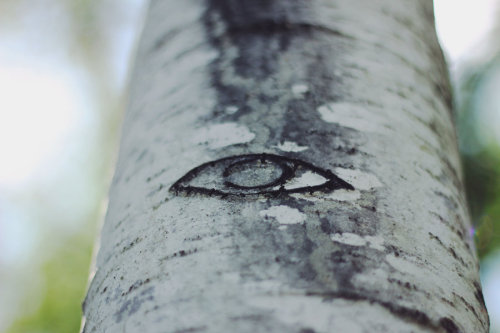I’ve Been Thinking About Places To Live, In The Desert And In Generally Hotter Climate, And The Idea

I’ve been thinking about places to live, in the desert and in generally hotter climate, and the idea of underground houses seemed like a good one. For now, here is a stairwell leading down to such a house, complete with tiny greenhouse. It has translucent solar panels as glass, which still let the red light through that plants need most.
More Posts from Copperfingertips and Others

Practical action + liaising with the local community = creating long term sustainable projects and ultimately a shift in culture.




Matt Zeilinger, Solarpunk Girl (portrait of Krishna Jaya)




By copyrighting his property as an artwork, he has prevented oil companies from drilling on it.
Peter Von Tiesenhausen has developed artworks all over his property in northern Alberta. There’s a boat woven from sticks that is gradually being reclaimed by the land; there is a fence that he adds to each year of his life, and there are many “watching” trees, with eyes scored into their bark.
Oil interests pester him continually about drilling on his land. His repeated rebuffing of their advances lead them to move toward arbitration. They made it very clear that he only owned the top 6 inches of soil, and they had rights to anything underneath. He then, off the top of his head, threatened them that he would sue damages if they disturbed his 6 inches, for the entire property is an artwork. Any disturbance would compromise the work, and he would sue.
Immediately after that meeting, he called a lawyer (who is also an art collector) and asked if his intuitive threat would actually hold legally. The lawyer visited, saw the scope of the work on the property, and wrote a document protecting the artwork.
The oil companies have kept their distance ever since.
This is but one example of Peter’s ability to negotiate quickly on his feet, and to find solutions that defy expectations.
The village of Kamikatsu in Japan has taken their commitment to sustainability to a new level. While the rest of the country has a recycling rate of around 20 percent, Kamikatsu surpasses its neighbors with a staggering 80 percent.
video / youtubechannel : Great Big Story

~ the pondering muse🌙
Did you know you can grow mushrooms to eat by feeding them plastic? Or that mushrooms evolved this capability themselves? It’s true, plastic eating fungi has been found in landfills in Pakistan and it’s so prolific that it can break down polyester polyurethane in a matter of weeks. Mushrooms are great at bioremediation, so good at it fact, that they can suck radiation and heavy metals from the soil, eat plastic, petroleum, and remove CO2.
The mini farm designed to grow these amazing plastic eating fungi is called the “Fungi Mutarium” and it allows for the cultivation of Schizophyllum commune and Pleurotus ostreatus. The steps to degrade the plastic are simple and can be found below:
- UV sterilize the materials and chambers.
- Place the plastic into a “growth sphere” an egg shaped pod of agar agar.
- Add diluted mycelium culture to the “growth spheres” within the incubator.
It’s simple isn’t it? And the end product resembles an edible food bowl or cup that you can put salad in. Research is still being done to make sure it’s 100% safe to consume and no doubt free of micro-plastic residue, but even if this doesn’t get the green light for edibility, it would be a great way to process plastics at home with our current recycling issues here in the U.S.
You can read more here.
what skincare culture should be: -strong encouragement to use sunscreen and stay away from tanning booths -encouraging little black and brown kids to love their skin color, giving love to people with skin conditions such as vitiligo/albinism/hyper-pigmentation/etc. -good smelling lotion for all what skincare culture is: -unless a women has totally clear poreless pale skin that glows like paintings like the virgin mary she is gross and unhygienic and doesn’t take care of herself -don’t want to be that girl? spend $1000 a year on expensive goo sold by glossier and lush and inject weird chemicals in your skin to get rid of freckles and moles and wrinkles even though you’re only like 25

Researchers at Michigan State University have created a fully transparent solar concentrator, which could turn any window or sheet of glass (like your smartphone’s screen) into a photovoltaic solar cell. Unlike other “transparent” solar cells that we’ve reported on in the past, this one really is transparent, as you can see in the photos throughout this story. According to Richard Lunt, who led the research, the team are confident that the transparent solar panels can be efficiently deployed in a wide range of settings, from “tall buildings with lots of windows or any kind of mobile device that demands high aesthetic quality like a phone or e-reader.”

Purple Dragon aesthetic
-
 magic-and-shit-idek reblogged this · 3 months ago
magic-and-shit-idek reblogged this · 3 months ago -
 planetary-ecologist liked this · 8 months ago
planetary-ecologist liked this · 8 months ago -
 jukeblocked reblogged this · 1 year ago
jukeblocked reblogged this · 1 year ago -
 jukeblocked liked this · 1 year ago
jukeblocked liked this · 1 year ago -
 kaleidoscopebb liked this · 1 year ago
kaleidoscopebb liked this · 1 year ago -
 antlerdyke liked this · 1 year ago
antlerdyke liked this · 1 year ago -
 yenoodlethings liked this · 1 year ago
yenoodlethings liked this · 1 year ago -
 randomwizard21 liked this · 2 years ago
randomwizard21 liked this · 2 years ago -
 letssgolesbians liked this · 2 years ago
letssgolesbians liked this · 2 years ago -
 ceramic-tiger-wearing-shoes reblogged this · 2 years ago
ceramic-tiger-wearing-shoes reblogged this · 2 years ago -
 crowoffrond liked this · 3 years ago
crowoffrond liked this · 3 years ago -
 thechiwasadrugthewholetime liked this · 3 years ago
thechiwasadrugthewholetime liked this · 3 years ago -
 arrol liked this · 3 years ago
arrol liked this · 3 years ago -
 notapricot liked this · 3 years ago
notapricot liked this · 3 years ago -
 mercyankh liked this · 3 years ago
mercyankh liked this · 3 years ago -
 nokashikiari liked this · 3 years ago
nokashikiari liked this · 3 years ago -
 caffinated-dragon liked this · 3 years ago
caffinated-dragon liked this · 3 years ago -
 yesladywitch reblogged this · 3 years ago
yesladywitch reblogged this · 3 years ago -
 yesladywitch liked this · 3 years ago
yesladywitch liked this · 3 years ago -
 feral-gremlinsoup liked this · 3 years ago
feral-gremlinsoup liked this · 3 years ago -
 middle-child-of-eternity reblogged this · 3 years ago
middle-child-of-eternity reblogged this · 3 years ago -
 thesolarpunkworld reblogged this · 3 years ago
thesolarpunkworld reblogged this · 3 years ago -
 camcam6820 reblogged this · 3 years ago
camcam6820 reblogged this · 3 years ago -
 camcam6820 liked this · 3 years ago
camcam6820 liked this · 3 years ago -
 readasaur reblogged this · 3 years ago
readasaur reblogged this · 3 years ago -
 spikeymagpie liked this · 3 years ago
spikeymagpie liked this · 3 years ago
